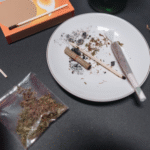
I’ve been writing about cannabis and wellness for years, and if there’s one question that keeps popping up in my inbox, it’s this: “Does smoking weed have calories?” It’s a fair concern, especially if you’re watching your weight or tracking your nutrition.
Let me cut to the chase: smoking or vaping cannabis contains zero calories. When you inhale cannabis smoke or vapor, you’re not consuming anything that your body processes as food energy.
But that’s just the beginning of the story. Cannabis interacts with your body in fascinating ways that can impact your diet and weight beyond simple calorie counting. Let’s break it down.
The Calorie Content of Different Cannabis Consumption Methods
As someone who’s researched cannabis extensively (and yes, done my fair share of personal “research” too), I can confirm that different consumption methods have wildly different caloric impacts:
Smoking/Vaping: 0 calories. When you smoke or vape, you’re inhaling compounds like THC and CBD directly into your bloodstream through your lungs. Your digestive system isn’t involved, so no calories are absorbed.
Edibles: This is where calories come into play. A cannabis brownie might pack 200-500 calories, while a gummy could contain 10-20 calories per piece. Remember, these calories come from the ingredients (sugar, flour, oils), not from the cannabis itself.
Tinctures: Minimal calories, usually just from the carrier oil. A typical dropper might contain 5-10 calories at most.
Topicals/Transdermal Patches: Like smoking, these methods deliver cannabinoids directly into your system without caloric content. They bypass digestion completely, making them another zero-calorie option.
I once made the rookie mistake of munching through a whole package of cannabis cookies without checking the nutrition label. Let’s just say I wasn’t just high, I’d also consumed about 1,200 unexpected calories! Lesson learned: Always check the label.
The Science Behind the Munchies
We’ve all been there. One minute you’re enjoying a smoke session, the next you’re raiding the fridge like it’s your last meal. But why?
THC, the main psychoactive compound in cannabis, binds to receptors in your brain that regulate hunger. Specifically, it triggers the release of ghrelin (your “hunger hormone”) and boosts dopamine, making food taste absolutely amazing.
I’ve found that certain strains hit the munchie button harder than others. Indica-dominant varieties often send me straight to the kitchen, while some sativas barely affect my appetite at all.
For those who want to feel the effects of cannabis without emptying the refrigerator, several strains are known for minimizing munchies. My friend Jake swears by Durban Poison for this reason. It gives him the creative boost he wants without the midnight pantry raids. Other low-munchie options include Blue Dream, THCV-rich strains, and many CBD-dominant varieties like CBD Lemon Auto.
Conversely, if you’re looking to stimulate your appetite (perhaps for medical reasons), strains like Limoncello, Funyunz, and most heavy indicas will have you reaching for snacks in no time.
Cannabis and Weight: The Surprising Connection
Here’s where things get interesting. Despite the munchies being real, research suggests that regular cannabis users actually tend to have lower BMIs (Body Mass Index) than non-users. Weird, right?
Scientists aren’t entirely sure why this paradox exists, but there are some compelling theories:
- Cannabis might boost metabolism in some people, helping them burn calories more efficiently
- Regular users develop tolerance to the appetite-stimulating effects over time
- Cannabis can reduce stress for some folks, potentially decreasing stress eating
- Certain cannabinoids like THCV might actually suppress appetite
- Cannabis users might have different lifestyle patterns that contribute to weight maintenance
I’ve noticed this paradox in my own life. During periods when I use cannabis more frequently, my weight stays surprisingly stable despite the occasional munchie-fueled snack attack.
Medical Applications for Appetite Stimulation
Beyond recreational use, cannabis has established medical applications for appetite stimulation. For patients undergoing chemotherapy, living with HIV/AIDS, or dealing with conditions that cause appetite loss, cannabis can be life-changing.
Medical-grade cannabis products like Marinol (synthetic THC) are specifically prescribed to combat wasting syndrome and stimulate appetite in clinical settings. For these patients, the caloric “side effect” of increased hunger is actually the primary benefit.
A colleague who works in oncology shared that many of her patients credit cannabis with helping them maintain nutrition during treatment. “Some patients simply wouldn’t be able to eat enough calories without it,” she explained. “The appetite stimulation can be crucial for recovery.”
Practical Tips for Calorie-Conscious Cannabis Users
If you’re watching your calories but still want to enjoy cannabis, I’ve got some real-world advice:
Choose your consumption method wisely: If calories are a concern, smoking, vaping, topicals, or patches are your best bet. I keep a vape pen handy for when I want to enjoy cannabis without the caloric impact of edibles.
Plan for the munchies: Prepare healthy snacks before you consume cannabis. Cut veggies, fruit, or air-popped popcorn can satisfy the craving without blowing your calorie budget. I portion snacks ahead of time to avoid mindless eating.
Stay hydrated: Sometimes, thirst masquerades as hunger. I keep a big water bottle nearby and often find that what I thought was hunger was actually thirst. Some studies suggest that hydration can help moderate cannabis-induced appetite increases.
Time your sessions strategically: Consider using cannabis after meals when you’re already full rather than before eating. This simple timing change can dramatically reduce excess calorie consumption.
Read edible labels carefully: Not all edibles are created equal. Some cannabis beverages pack 200+ calories, while others might have just 10-20. I always check before consuming.
Try different strains: I’ve experimented with dozens of strains and found huge differences in how they affect my appetite. Keep a journal to track which ones trigger your munchies the most. THCV-rich strains like Doug’s Varin and Durban Poison are known for their appetite-suppressing properties.
Set environmental controls: Keep tempting, high-calorie foods out of reach during cannabis sessions. I’ve found that simply not having ice cream in the freezer is sometimes the best strategy!
The Bottom Line on Cannabis and Calories
Cannabis itself isn’t inherently fattening. Smoking or vaping adds zero calories to your diet. The real caloric impact comes from:
- What you consume (edibles vs. smoking)
- How you respond to the munchies
- Your overall lifestyle habits
I’ve seen cannabis fit beautifully into health-conscious lifestyles and derail diet plans completely. The difference usually comes down to mindfulness and planning.
One client I worked with actually incorporated cannabis into her weight loss journey. She’d smoke a small amount before gentle yoga, which helped her connect with her body and reduce anxiety-driven snacking. She lost 30 pounds over six months while continuing to enjoy cannabis moderately.
Finding Your Balance
Cannabis can absolutely be part of a healthy, balanced lifestyle, calories and all. The key is understanding how it affects you personally and planning accordingly.
I’ve found that being honest with myself about my habits makes all the difference. If I know I’m prone to munchies with certain strains, I either avoid them when I’m watching my calories, or I prepare by having only healthy options available.
Remember that everyone’s endocannabinoid system is different. What causes insatiable hunger in one person might barely affect another. Pay attention to your body’s signals and adjust accordingly.
Cannabis isn’t inherently good or bad for your diet. It’s all in how you use it. And now that you understand the caloric impact (or lack thereof) of smoking weed, you can make more informed choices about how cannabis fits into your wellness routine.
What questions do you still have about cannabis and nutrition? I’m always curious to hear what’s on your mind!





